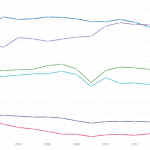
Italy, on the Euro, has a currency that is 9% too high. Germany, on the Euro, has a currency that is 11% too low.
There was much discussion yesterday about the US Treasury report that determined China was not a currency manipulator.
However, there are six countries on the manipulation watch list: China, Japan, Korea, India, Germany, and Switzerland.
Japan, Germany, and Korea have met two of the three criteria in every Report since the April 2016 Report having material current account surpluses combined with significant bilateral trade surpluses with the United States.
Germany has the world’s largest current account surplus in nominal dollar terms, $329 billion over the four quarters through June 2018, which represented its highest nominal level on record. Germany also maintains a sizable bilateral goods trade surplus with the United States, at $67 billion over the four quarters through June 2018. There has been essentially no progress in reducing either the massive current account surplus or the large bilateral trade imbalance with the United States in recent years, in part because domestic demand in Germany has not been sufficiently strong to facilitate external rebalancing and because Germany’s low inflation rate has contributed to a weak real effective exchange rate.
Try Fixing This
The Euro is 11% undervalued in Germany, the largest Eurozone economy.
The Euro is 9% overvalued in Italy, the third largest Eurozone economy.
The normal way central banks make adjustments to fix over-valued or undervalued situation is through interest rate policy or direct currency intervention.
No matter which the ECB does, it will impact Italy and Germany in opposite directions.
Meanwhile, interest rates are on the verge of spiraling out of control in Italy.
Italy vs Germany 10-Year Bond Spread

Theory vs Practice
In theory, German, Italian, and Greek 10-year bonds should all have the same yield. In practice, they clearly don’t.











Leave A Comment